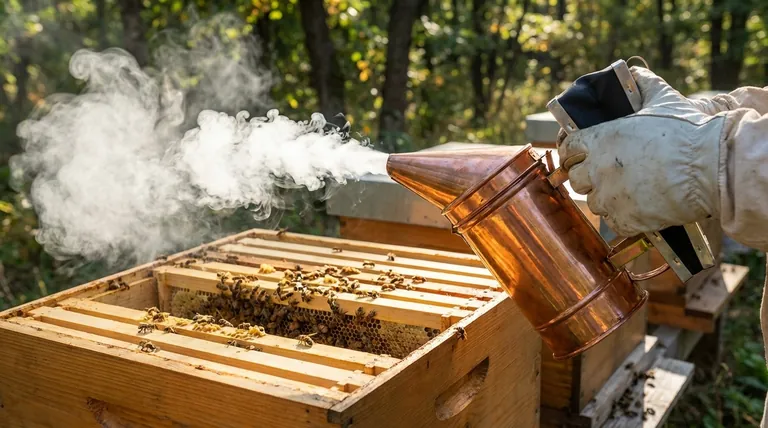A bee smoker is a handheld device used by beekeepers to generate cool smoke, which serves the primary purpose of calming honey bees. This allows for safe and less stressful hive inspections for both the beekeeper and the bees themselves.
The smoker’s effectiveness lies not in sedation, but in triggering the bees' natural survival instincts. By simulating a distant fire, it prompts a non-aggressive, honey-gorging response that makes the colony far more manageable.

How Smoke Calms a Bee Colony
The smoke produced by the smoker is a powerful communication tool that leverages the bees' innate behaviors developed over millions of years.
Triggering a Survival Instinct
When bees detect smoke, they interpret it as a sign of a nearby forest fire. This initiates an instinctual emergency protocol within the hive.
Their immediate priority shifts from defending the colony to preparing for potential evacuation.
The Honey-Gorging Effect
In preparation to abandon the hive, bees rush to consume as much honey as possible. This ensures they have the energy reserves to travel and establish a new home.
When a bee's stomach is full of honey, its abdomen is physically distended. This makes it difficult for the bee to bend into the proper position to deploy its stinger, significantly reducing its ability and inclination to sting.
The Anatomy of a Bee Smoker
A bee smoker is a simple yet highly effective tool composed of a few key parts that work together to produce a steady stream of cool, thick smoke.
The Fire Chamber
This is the main metal canister where the fuel is placed to smolder. It's often made of stainless steel and includes an internal grate or cup to hold the fuel off the bottom, ensuring proper airflow.
The Bellows
Typically made of wood and leather, the bellows act as the smoker's engine. When squeezed, they pump a jet of oxygen into the bottom of the fire chamber.
This targeted airflow keeps the fuel smoldering without bursting into open flame and pushes the resulting smoke out of the nozzle.
The Nozzle
The tapered cone at the top of the fire chamber is the nozzle. It directs the smoke into a concentrated stream, allowing the beekeeper to apply it precisely where needed, such as at the hive entrance or over the top of the frames.
Protective Guards
Most smokers include a metal guard or heat shield built around the fire chamber. This is a critical safety feature that protects the beekeeper from burns during operation.
Common Pitfalls and Proper Usage
While essential, a smoker is only effective when used correctly. Misunderstanding its purpose can lead to an agitated, rather than a calm, colony.
The Goal is Cool Smoke, Not Heat
The objective is to create a smoldering fire that produces thick, cool smoke. An open flame or hot embers can harm the bees and damage the hive.
The design of the smoker, with its limited airflow, is intended to facilitate smoldering, not burning.
Use Gentle Puffs, Not Blasts
The smoker is a communication tool, not a weapon. A few gentle puffs at the hive entrance and under the lid are usually sufficient.
Aggressively blasting smoke directly onto the bees will be interpreted as a direct threat, negating the calming effect and potentially escalating their defensive response.
Choosing the Right Fuel
The best fuels are natural materials that smolder well and produce dense smoke. Beekeepers commonly use burlap, untreated wood shavings, dry leaves, or corn cobs.
How to Apply This to Your Beekeeping
Understanding the "why" behind the smoker allows you to use it with intention and skill.
- If your primary focus is a peaceful hive inspection: Apply a few puffs at the hive entrance 1-2 minutes before opening it to allow the effect to spread through the colony.
- If your primary focus is personal safety: Always handle the smoker by the bellows or the hook, never the hot fire chamber, and ensure the heat shield is in place.
- If your primary focus is bee welfare: Use only as much smoke as is necessary to keep the bees calm, recognizing that you are intentionally triggering a stress response for a specific management purpose.
Mastering the bee smoker is a fundamental step in learning how to work with a honey bee colony safely and respectfully.
Summary Table:
| Component | Primary Function |
|---|---|
| Fire Chamber | Holds fuel for a controlled, smoldering fire. |
| Bellows | Pumps oxygen to maintain smoke production. |
| Nozzle | Directs a concentrated stream of cool smoke. |
| Heat Shield | Protects the beekeeper from burns. |
Ready to Master Your Hive Inspections?
A reliable bee smoker is fundamental to safe and effective beekeeping. HONESTBEE supplies commercial apiaries and beekeeping equipment distributors with high-quality, durable smokers and other essential beekeeping supplies through our wholesale-focused operations.
Ensure your operations run smoothly with equipment built for professionals. Contact HONESTBEE today to discuss your wholesale needs.
Visual Guide

Related Products
- Premium Traditional Copper Bee Smoker with Bellows
- Stainless Steel Honey Bee Smoker Hive and Honeycomb Smoker for Beekeeping
- Economy Galvanized Beekeeping Honey Bee Smoker for Wholesale
- Professional Bee Smoker with Elongated Spout and Durable Bellows for Beekeeping
- Heavy Duty Manual Bee Smoker Blower for Beekeeping
People Also Ask
- What are some alternatives to using smoke in beekeeping? A Guide to Gentle Hive Management
- What is the primary purpose of using smoke in beekeeping? Calm Bees for Safer Hive Management
- How did early beekeepers use bee smokers? Master Ancient Bee Calming Techniques
- What are the main components of a bee smoker? A Guide to Safe and Effective Hive Management
- How does water mist work as an alternative to smoke in beehives? A Guide to Safe & Effective Use



















